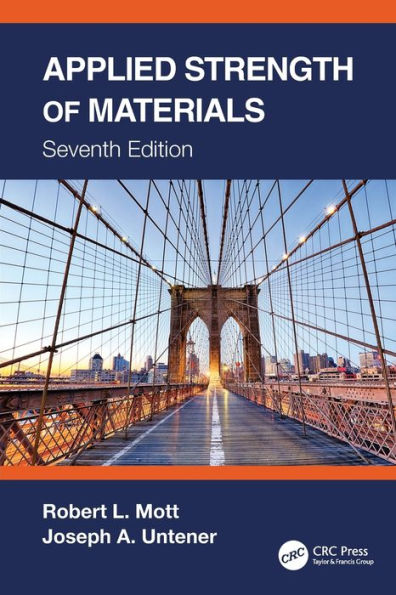Table of Contents
Preface xi
Acknowledgments xvii
Authors xix
Introduction xxi
1 Basic Concepts in Strength of Materials 1
Exploration 2
1-1 Objective of This Book: To Ensure Safety 6
1-2 Objectives of This Chapter 18
1-3 Basic Unit Systems 19
1-4 Mass, Force, and Weight 21
1-5 Concept of Stress 23
1-6 Direct Normal Stress 26
1-7 Stress Elements for Direct Normal Stresses 29
1-8 Concept of Strain 31
1-9 Direct Shear Stress 32
1-10 Stress Elements for Shear Stresses 38
1-11 Commercially Available Standard Shapes 39
1-12 Preferred Sizes and Screw Threads 50
1-13 Review of the Fundamentals of Statics 52
References 67
Internet Sites 67
Problems 69
2 Design Properties of Materials 91
Exploration 92
2-1 Objectives of This Chapter 93
2-2 Design Properties of Materials 95
2-3 Steel 115
2-4 Cast Iron 125
2-5 Aluminum 127
2-6 Copper, Brass, and Bronze 129
2-7 Zinc-, Magnesium-, Titanium-, and Nickel-Based Alloys 130
2-8 Nonmetals in Engineering Design 132
2-9 Wood 133
2-10 Concrete 134
2-11 Plastics 138
2-12 Composites 141
2-13 Materials Selection 155
References 159
Internet Sites 161
Problems 163
3 Direct Stress, Deformation, and Design 169
Exploration 170
3-1 Objectives of This Chapter 175
3-2 Applied Normal Stress 175
3-3 Design Normal Stress 176
3-4 Determination of Design Factor 177
3-5 Methods of Computing Design Stress 182
3-6 Elastic Deformation in Tension and Compression Members 189
3-7 Stress Concentration Factors for Direct Axial Stresses 197
3-8 Applied Bearing Stress 202
3-9 Design Bearing Stress 207
References 215
Problems 216
4 Design for Direct Shear, Torsional Shear, and Torsional Deformation 237
Exploration 238
4-1 Objectives of This Chapter 245
4-2 Design Shear Stress 245
4-3 Transmitting Power through Rotating Shafts 251
4-4 Applied Torsional Shear Stress in Members with Circular Cross Sections 256
4-5 Development of the Torsional Shear Stress Formula 260
4-6 Polar Moment of Inertia for Solid Circular Bars 262
4-7 Torsional Shear Stress and Polar Moment of Inertia for Hollow Circular Bars 262
4-8 Design of Circular Members under Torsion 266
4-9 Comparison of Solid and Hollow Circular Members 269
4-10 Stress Concentrations in Torsionally Loaded Members 274
4-11 Twisting: Elastic Torsional Deformation 283
4-12 Torsion In Noncircular Sections 296
References 304
Internet Sites 304
Problems 305
5 Shearing Forces and Bending Moments in Beams 335
Exploration 336
5-1 Objectives of This Chapter 345
5-2 Beam Loading, Supports, and Types of Beams 345
5-3 Reactions at Supports 356
5-4 Shearing Forces and Bending Moments for Concentrated Loads 362
5-5 Guidelines for Drawing Beam Diagrams for Concentrated Loads 368
5-6 Shearing Forces and Bending Moments for Distributed Loads 378
5-7 General Shapes Found in Bending Moment Diagrams 386
5-8 Shearing Forces and Bending Moments for Cantilever Beams 388
5-9 Beams with Linearly Varying Distributed Loads 390
5-10 Free-Body Diagrams of Parts of Structures 392
5-11 Mathematical Analysis of Beam Diagrams 399
5-12 Continuous Beams: Theorem of Three Moments 413
Problems 420
6 Centroids and Moments of Inertia of Areas 449
Exploration 450
6-1 Objectives of This Chapter 453
6-2 Concept of Centroid: Simple Shapes 454
6-3 Centroid of Complex Shapes 454
6-4 Concept of Moment of Inertia of an Area 460
6-5 Moment of Inertia of Composite Shapes Whose Parts Have the Same Centroidal Axis 464
6-6 Moment of Inertia for Composite Shapes: General Case-Use of the Parallel Axis Theorem 466
6-7 Mathematical Definition of Moment of Inertia 470
6-8 Composite Sections Made from Commercially Available Shapes 472
6-9 Moment of Inertia for Shapes with All Rectangular Parts 476
6-10 Radius of Gyration 478
6-11 Section Modulus 482
References 484
Internet Suites 485
Problems 486
Computer Assignments 505
7 Stress due to Bending 507
7-1 Objectives of This Chapter 512
7-2 Flexure Formula 513
7-3 Conditions on the Use of the Flexure Formula 517
7-4 Stress Distribution on a Cross Section of a Beam 520
7-5 Derivation of the Flexure Formula 522
7-6 Applications: Analysis of Stresses in Beams 524
7-7 Applications: Beam Design and Design Stresses 529
7-8 Section Modulus and Design Procedures 533
7-9 Stress Concentrations 540
7-10 Flexural Center or Shear Center 548
7-11 Preferred Shapes for Beam Cross Sections 552
7-12 Design of Beams to Be Made from Composite Materials 558
References 559
Internet Sites 560
Problems 561
8 Shearing Stresses in Beams 603
8-1 Objectives of This Chapter 609
8-2 Importance of Shearing Stresses in Beams 610
8-3 General Shear Formula 612
8-4 Distribution of Shearing Stress in Beams 620
8-5 Development of the General Shear Formula 628
8-6 Special Shear Formulas 631
8-7 Design for Shear 637
8-8 Shear How 639
References 643
Problems 644
Additional Practice and Review Problems 662
9 Deflection of Beams 665
9-1 Objectives of This Chapter 674
9-2 Need for Considering Beam Deflections 675
9-3 General Principles and Definitions of Terms 677
9-4 Beam Deflections Using the Formula Method 681
9-5 Comparison of the Manner of Support for Beams 689
9-6 Superposition Using Deflection Formulas 698
9-7 Successive Integration Method 708
9-8 Moment-Area Method 724
References 749
Internet Sites 750
Problems 750
Computer Assignments 767
10 Combined Stresses 769
10-1 Objectives of This Chapter 776
10-2 Stress Element 777
10-3 Stress Distribution Created by Basic Stresses 778
10-4 Creating the Initial Stress Element 782
10-5 Combined Normal Stresses 788
10-6 Combined Normal and Shear Stresses 797
10-7 Equations for Stresses in Any Direction 804
10-8 Maximum and Minimum Stresses 808
10-9 Mohr's Circle for Stress 812
10-10 Stress Condition on Selected Planes 831
10-11 Special Case in Which Both Principal Stresses Have the Same Sign 836
10-12 Use of Strain-Gage Rosettes to Determine Principle Stresses 842
References 851
Internet Sites 851
Problems 852
Computer Assignments 874
11 Columns 875
11-1 Objectives of This Chapter 881
11-2 Slenderness Ratio 882
11-3 Transition Slenderness Ratio 888
11-4 Euler Formula for Long Columns 890
11-5 J.B. Johnson Formula for Short Columns 891
11-6 Summary: Buckling Formulas 891
11-7 Design Factors for Columns and Allowable Load 895
11-8 Summary: Method of Analyzing Columns 895
11-9 Column Analysis Spreadsheet 901
11-10 Efficient Shapes for Column Cross Sections 903
11-11 Specifications of the AISC 904
11-12 Specifications of the Aluminum Association 908
11-13 Noncentrally Loaded Columns 909
References 917
Problems 917
Additional Review and Practice Problems 924
Computer Assignments 930
12 Pressure Vessels 931
12-1 Objectives of This Chapter 936
12-2 Distinction between Thin-Walled and Thick-Walled Pressure Vessels 937
12-3 Thin-Walled Spheres 938
12-4 Thin-Walled Cylinders 941
12-5 Thick-Walled Cylinders and Spheres 946
12-6 Analysis and Design Procedures for Pressure Vessels 947
12-7 Spreadsheet Aid for Analyzing Thick-Walled Spheres and Cylinders 956
12-8 Shearing Stress in Cylinders and Spheres 957
12-9 Other Design Considerations for Pressure Vessels 962
12-10 Composite Pressure Vessels 965
References 966
Internet Sites 967
Problems 969
Computer Assignments 972
13 Connections 975
13-1 Objectives of This Chapter 980
13-2 Modes of Failure for Bolted Joints 980
13-3 Design of Bolted Connections 982
13-4 Riveted Joints 986
13-5 Eccentrically Loaded Riveted and Bolted Joints 988
13-6 Welded Joints with Concentric Loads 993
References 997
Internet Sites 997
Problems 1000
14 Thermal Effects and Elements of More than One Material 1005
14-1 Objectives of This Chapter 1007
14-2 Deformation due to Temperature Changes 1007
14-3 Thermal Stress 1013
14-4 Members Made of More than One Material 1017
Problems 1021
Appendix 1029
Index 1141



